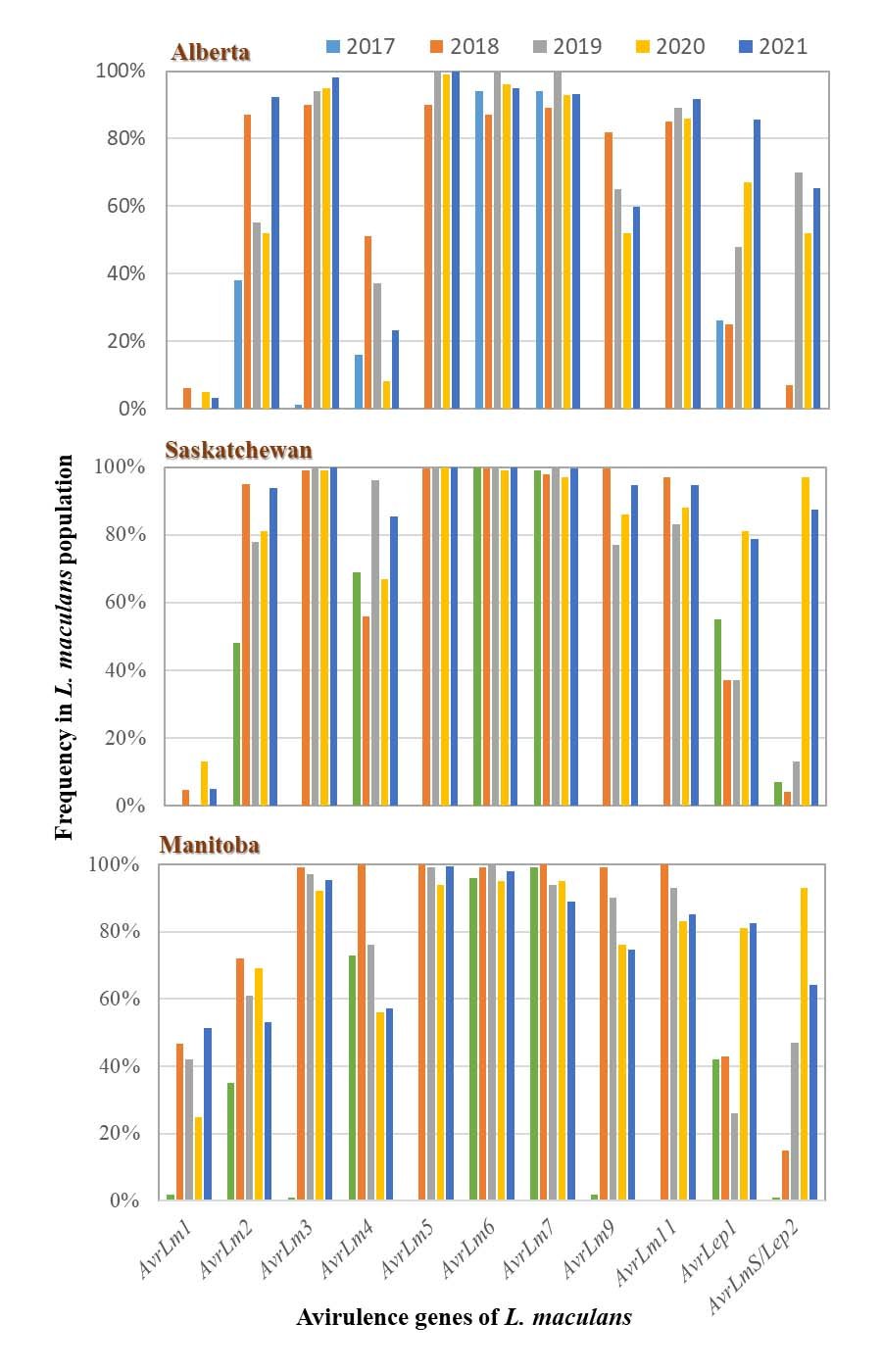Monitoring the race dynamics of Leptosphaeria maculans for effective deployment and rotation of resistance genes for sustainable management of blackleg of canola in Western Canada
Researcher(s): Gary Peng, Fengqun Yu; AAFC
Term: 5 years ending March 2023
Status: Complete
SaskCanola Investment: $91,667.67
Total Project Cost: $183,333.34
Funding Partners: ACPC, MCGA
Grower Benefits
The avirulence profile of L. maculans population remained relatively stable during 2017 to 2021; only AvrLep1 increased noticeably in each of the prairie provinces. KASP markers were developed and adopted, which improved the efficiency, scope and accuracy of Avr analysis. The current pathogen population was still highly diverse, especially in Manitoba; for all R genes except Rlm10, a virulent race has already been present in the pathogen population.
The study identified the pattern of Avr dynamics in the L. population in western Canada between 2017 and 2021, which has prompted the deployment of new R genes, including Rlm2, Rlm4 and Rlm7, in canola cultivars. Using the information, growers and agronomists can better select/rotate canola cultivars with effective R genes for management of blackleg on a regional basis.
Project Summary
For specific R genes to be effective in management of blackleg, it is essential to understand the pathogen race composition and changes in different regions. The analysis of Avr-gene frequency in the L. maculans population provides an important guidance to the selection of effective R genes in blackleg resistance breeding, as well as to the recommendation of canola cultivars carrying proper/effective R genes. This study also allowed early detection of virulent races capable of overcoming the R genes used in the current canola cultivars.
The key objectives were to: 1) monitor and analyze the pathogen population to gain insights into race dynamics and population virulence; 2) provide industry and producers with up-to-date pictures on L. maculans population virulence in the prairie provinces to guide the selection and recommendation of effective R genes for blackleg resistance breeding and disease management; 3) understand the diversity of L. maculans population and identify pathogen races capable of overcoming common R genes in canola cultivars before widespread breakdown of the resistance; and 4) evaluate, develop and adopt markers for efficient L. maculans race monitoring.
Canola stubble with blackleg symptoms were collected during canola disease surveys organized by the provincial Pathologists/Coordinators in Alberta, Saskatchewan and Manitoba, respectively. These samples were processed to obtain about 500 L. maculans isolates each year and tested for presence/absence of target Avr genes using KASP markers (AvrLm1,2,3,4,5,6,7,9,11,S-Lep2) and/or host differentials (only AvrLep1 after 2018). In total, about 2,600 L. maculans isolates were analyzed for the entire study over the 5-year period.
Blackleg samples were from provincial canola disease surveys in commercial fields, which would represent the current L. maculans population and canola cultivars carrying different R genes well. The diversity and virulence profile of the pathogen population is highly relevant to the conditions under which canola crops are produced.
The study shows that canola cultivars carrying any of the resistance genes Rlm5, Rlm6, Rlm7, Rlm10, Rlm11 and LepR1 are likely resistant to blackleg in western Canada due to common presence of corresponding Avr genes in the pathogen population. The resistance genes Rlm3 or Rlm9 may be ineffective due to the ‘masking effect’ of AvrLm7 to AvrLm3 and AvrLm9. Rlm4 may be less effective in Alberta due to low levels of AvrLm4.
A total of 83 races were identified in the L. maculans population, with top-10 races accounting for 72.3%, 93.7% and 57.1% in Alberta, Saskatchewan and Manitoba. The diversity in pathogen shows the potential for resistance erosion as virulent races had already been present for all R genes, except Rlm10. To manage selection pressure/resistance breakdown, judicious uses of R genes will be important.
The Avr profile of L. maculans population stayed relatively stable between 2017 and 2021; only AvrLep1 increased noticeably. With the introduction of new R genes in canola cultivars, including Rlm2, Rlm4, Rlm7 and LepR2, it will be important to continue monitoring the pathogen population for early detection of resistance erosion.
Figure 1. Avirulence (Avr) gene frequencies in the population of Leptosphaeria maculans on the Canadian prairies in 2021.
Figure 4. Avirulence (Avr) gene frequencies in the population of Leptosphaeria maculans on the Canadian prairies between 2017 and 2021.


